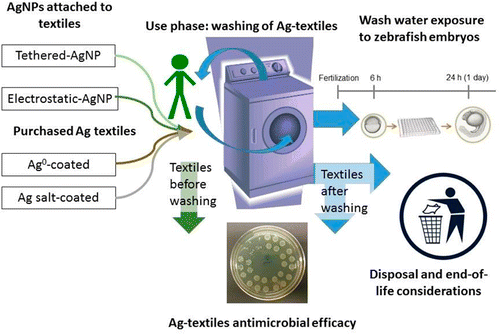The impact of anti-odor clothing on the environment

Anti-odor athletic clothes containing silver nanoparticles have gained a foothold among exercise buffs, but questions have arisen over how safe and effective they are. Now scientists report in ACS' journal Environmental Science & Technology that silver nanoparticles and coatings do wash off of commercially available garments in the laundry but at negligible levels. They also found that even low concentrations of silver on clothing kept microbes at bay.
Thanks to their antimicrobial properties, silver nanoparticles are found in an increasing array of products such as food packaging, bandages and textiles. At the same time, scientists have been studying the possible effects silver nanoparticles might have on the environment and human health. Studies have shown that the particles can be toxic, but their safety is dependent on a number of factors such as size and dose. Few studies, however, have examined both their effectiveness in products and their potential for harm. Paul K. Westerhoff and colleagues wanted to see how the design of antimicrobial clothes affects how well they stand up to washing and their potential to leach silver into the environment.
The researchers tested commercial athletic shirts in which the silver nanoparticles were incorporated in one of four different ways. Washing the shirts released a range of silver concentrations, depending on how the nanoparticles were attached. But overall, the resulting toxicity of the wastewater due to its silver content was negligible to zebrafish embryos—a model animal used in toxicity studies. And after washing, the shirts still retained their antimicrobial effect even if their remaining metal concentration was low. The researchers also say, however, that the remaining silver will leach out over time when the clothes are discarded in landfills. They recommend keeping the initial metal concentration in these products low to help reduce their environmental impact while still maintaining their ability to fight off microbes.
The authors acknowledge funding from the U.S. Environmental Protection Agency.
More information: Robert B. Reed et al. Potential Environmental Impacts and Antimicrobial Efficacy of Silver- and Nanosilver-Containing Textiles, Environmental Science & Technology (2016). DOI: 10.1021/acs.est.5b06043
Abstract
For textiles containing nanosilver, we assessed benefit (antimicrobial efficacy) in parallel with potential to release nanosilver (impact) during multiple life cycle stages. The silver loading and method of silver attachment to the textile highly influenced the silver release during washing. Multiple sequential simulated household washing experiments for fabric swatches in deionized water with or without detergent showed a range of silver release. The toxicity of washing experiment supernatants to zebrafish (Danio rerio) embryos was negligible, with the exception of the very highest Ag releases (∼1 mg/L Ag). In fact, toxicity tests indicated that residual detergent exhibited greater adverse response than the released silver. Although washing the fabrics did release silver, it did not affect their antimicrobial efficacy, as demonstrated by >99.9% inhibition of E. coli growth on the textiles, even for textiles that retained as little as 2 μg/g Ag after washing. This suggests that very little nanosilver is required to control bacterial growth in textiles. Visible light irradiation of the fabrics reduced the extent of Ag release for textiles during subsequent washings. End-of-life experiments using simulated landfill conditions showed that silver remaining on the textile is likely to continue leaching from textiles after disposal in a landfill.
Journal information: Environmental Science & Technology
Provided by American Chemical Society


















